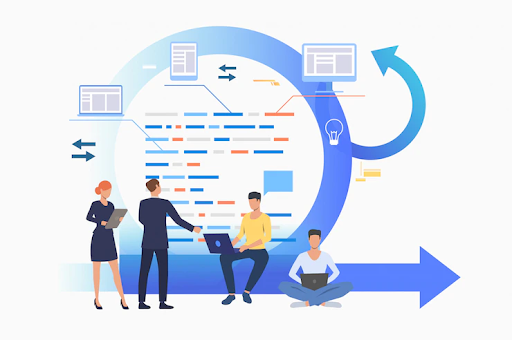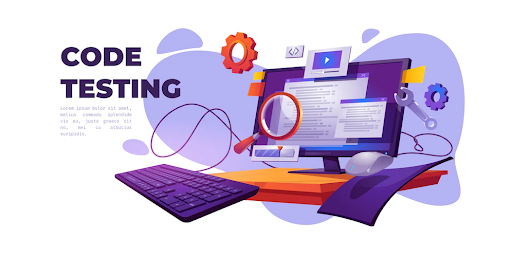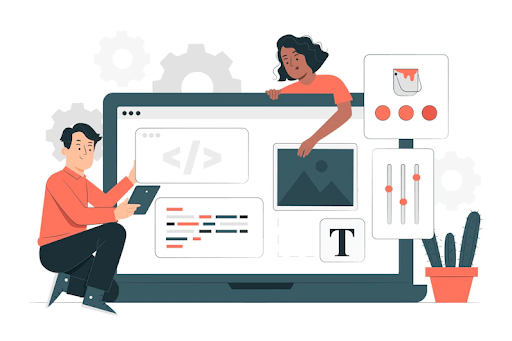

Software Development
Digital technology has facilitated the automation of different activities. Businesses, individuals and developers rely on diverse software products to manage workflows and solve several activities. The digital space features different software categories that address consumer issues, business-to-business collaborations, business-to-customer communications and fulfillment. Software products undergo a rigorous development process to ensure they are functional, safe and reliable for specific business use cases.
Have a physical product or mobile app idea you want to monetize?
What does software development entail? How do development processes vary for each software category? In this article, we explore the ins and outs of software development, its benefits, software development methodologies and the typical development processes. We also highlight the strides that Stokeventures has made to become a globally approved software development partner. We also highlight the strides that Stoke Ventures, a reliable Enterprise Software Development Company, has made to become a globally approved software development partner and a reputable cross-platform app development company. Within the scope of Software Development we offer the following services:
What is software development?
Before exploring the development process, we should first understand what software is. Software is a program or advanced instructions that control how computers (including handheld devices) operate. Different types of computer software include:
- Programming software
- Application software
- System software
- Embedded software
Software development is a combination of structured processes for optimizing design, deployment and management of software products. The development process divides complex tasks into small, manageable tasks which run parallel or sequentially. The development process addresses predominant workflow challenges and creates functional, practical, and affordable solutions. The process starts with defining the expected deliverables, potential constraints, deployment activities and desired maintenance activities post-release.
Software development lifecycle (SDLC) is a term mentioned when discussing websites, mobile applications and related software products. SDLC defines step-by-step activities developers must follow to expedite product development and ensure the end product is qualitative and attractive to the user.

Coding follows a specific framework
The development lifecycle involves multiple tasks, each with unique complexities. It implies that some activities require the input of skilled individuals with extensive experience in particular niches. Segregation of development tasks enables the developers to prioritize tasks and estimate the effort and time required to deliver specific milestones. A single software can be developed by multiple individuals, including but not limited to:
- Software developers
- Programmers/coders
- Software engineers
The software development lifecycle is dynamic and requires proactivity and collaboration among the participating teams. When one development team lags, the entire project is delayed.
Software development methodologies
Agile development
Agile methodology is a flexible development process that relies on continuous improvement and team collaboration to minimize development lifecycle risks and ensure early market penetration. The developers collaborate with the customers or end users in planning, testing and updating software products. Agile development is evolutionary and accommodates regular changes depending on consumer preferences and prevailing market dynamics.
In agile development, planning and design work is divided into several segments. The teams execute these tasks incrementally and strive to complete tasks within short timelines. Cross-functional teams use design sprints to complete complex tasks within days or weeks. The purpose of iterations is to make changes to existing codes or software designs. The quick adaptation of changes in the development process allows the teams to identify and mitigate risks early. It prevents the release of unreliable or low-quality products.
Agile software development relies on multiple principles. Some of the agile principles include:
- Early delivery and continuous improvement of software products for ultimate customer satisfaction
- Close collaborations between cross-functional teams and target customers
- Dynamic development allows developers to make changes as many times as possible.
- Meticulous attention to detail and sustainable development

Iteration helps developers to overcome design challenges
Rapid Application Development
It is one of the popular software development methodologies suitable for iterative design processes. The methodology does not require planning before the development project begins. Instead, the developers intertwine planning activities with coding and subsequent prototyping processes. Software developers minimize time spent on pre-planning activities. It reduces the time required to code and launch software products. Rapid application development is favorable for developing complex systems that require frequent changes during the development stage.
The typical rapid application development (RAD) process begins with the specification of data models required in the development process. The teams can also identify the desired business models and develop structured techniques to match business goals and project objectives. They proceed to verify the proposed data models and development structures through well-structured prototyping processes. The stage is critical for refining the proposed data and process models. All these stages are iterative. The developers identify bottlenecks at every stage, identify suitable changes and implement them before proceeding to subsequent activities.
Since RAD is extensively used to develop new systems, it is necessary to accelerate coding and testing processes by creatively combining the technical requirements of the project and the company’s business goals. In brief, rapid application development combines multiple structured approaches, data-driven development processes and quick prototyping to guarantee early testing and market penetration.
Rapid application development is built around:
- Fast delivery of new, complex products at a low cost using iterative prototyping.
- Structured segmentation of development tasks to allow quick and easy modification of software codes to accommodate newer requirements or business specifications
- Minimizing product development risks through repetitive prototyping
- Developing high-quality software products using advanced development tools and ensuring active participation of end-users in the development process. Some popular tools used for rapid application development include code generators, object-oriented programming tools and graphic user interface (GUI) tools, among other advanced tools.
- Prioritizing business needs or customer requirements over the delivery methodology. It also involves setting realistic timelines to ensure the delivery of milestones is within schedule.
At the end of each successful stage, software developers document the changes. It enables them to keep a detailed database of development processes. Such initiatives are vital for future software upgrades and maintenance activities. The success of this methodology stems from the inclusive development process that ensures the end-user is part and parcel of the development process.
Waterfall Development
Some software development firms prefer the sequential development approach. This is what is commonly referred to as waterfall development. The development activities follow a particular sequence. It has extensive pre-planning to enable the developers to specify software requirements and development objectives. Waterfall development has the following sequential phases:
- Requirement analysis and specification
- Design
- Implementation
- Testing
- Integration
- Deployment and maintenance
Waterfall development is preferable among some developers. The team divides the development processes into small, sequential stages. Some of the activities are transferable from one development stage to the next. The developers allow an overlap of some activities and reversal of some software development activities if they interrupt workflow in subsequent phases.
When using waterfall development methodology, software engineers focus on planning. They define specific schedules and set milestones or goals the team must achieve to measure success between phases. There is tight control over which activities to perform at a particular time and custom software development cost. Therefore, the margin for error is slim. Any deviations will derail the project in terms of cost and time.
Another distinct feature of waterfall development is the specific documentation of activities. The supervisory team monitors the developers to ensure they abide by the provided documentation and guidelines. Activities of each phase are reviewed extensively against the project specification. The team leader must sign off the results of every successful phase before transitioning to the next one. Deliverables for each development stage are documented and filed.
Waterfall development is considered an old software development approach that is restrictive. The methodology restricts iteration or systematic changes to already completed phases. It makes it hard to revise software once they’re developed. The lack of flexibility means the waterfall development is unsuitable for complex development activities.
Spiral Development
Spiral development is a methodology seeking to eliminate the shortcomings of the waterfall model. It is an advanced method that combines the stages of waterfall development with rapid prototyping techniques. One thing defining spiral development is its emphasis on iterative risk analysis enabling developers to foresee design, implementation and maintenance constraints early.
The spiral development strategy is centered around the following principles:
Minimizing software development risks through extensive risk analysis and segmentation of development activities. Segmenting activities provide the flexibility needed by developers to repeatedly amend software specifications depending on feedback and emerging development constraints.
Each phase has a well-defined sequence of activities. The development team has a clear set of objectives and desired deliverables to measure success. Each development stage is documented upon completion.
The typical development process revolves around establishing project objectives and specifying viable alternatives, evaluating implementation alternatives, identifying potential risks and remediation activities, iterating and developing the most suitable alternative and planning for subsequent iterations.
Other development methodologies
Software development firms serve a specific target market, each with unique requirements and preferences. Since software developers are naturally innovative, they devise the most flexible methodologies to allow them to serve their clients better. All the methodologies mentioned above have unique benefits. They also have shortcomings that impede their implementation of certain software products. Below are other software development methodologies companies and innovators can use to bring their products to life.
- Behavior-driven software development
- V-model software development
- Unified process
- Structured system analysis and design
Have a physical product or mobile app idea you want to monetize?
Software Development Lifecycle
By now, it is clear that software development stages vary depending on the scope of the project and the preferred development methodology. Typically, the development process will include:
- Planning
- Design and Implementation
- Testing
- Deployment and Maintenance
Planning
Before approaching a software development company, a client needs to specify a need or a business problem that needs to be solved. The client prepares a brief problem description and submits it to the development company. The developer utilizes the information supplied by the client to create a requirement analysis plan. When the client presents a problem statement to the software development outsource, they provide an idea about what they plan to achieve and not what and how the software should address that.
During the planning phase, software engineers analyze available information to develop a set of objectives and define development goals. They eliminate contradictory information provided by the client and fill in any gaps existing.
Planning is necessary for comprehensively defining the problem and creating requisite documentation to guide multi-skilled software developers to achieve a common goal. At the end of the planning phase, the development team comes up with a comprehensive document detailing the project objectives, specific development milestones, implementation timelines, ways to measure success and cost analysis plans. The planning phase is also critical for risk analysis. The team identifies all the potential threats to the success of the project and brainstorms suitable risk mitigation measures. The goal of the planning stage is to prepare the developers for the task ahead and create boundaries to ensure everything is delivered timely. The work is also divided among teams so everyone understands what is expected of them at a particular time. It also enables the development teams to understand the depth of the task. For some development teams, the planning phase includes a feasibility study and a proof-of-concept based on available data, customer needs and insights from previous projects.
Design and Implementation
At this stage, the development team shifts from planning and begins solving the stated problem through coding. The first order of business is deciding which type of software product to develop. The team utilizes information from the planning stage to decide which tools to use when developing the software. They also determine which type of software product to create. Will a mobile application solve the problem? Or is a comprehensive database management system the most appropriate solution?
The developer drafts a simple design of the final product. Usually, the first step is to sketch the architecture of the desired end product. At this stage, developers focus on wireframe development. Wireframes enable software developers to visualize the critical software features and layouts. At the design stage, developers refine the UI UX design of software for ultimate user experiences and software functionality. Defining the architecture enables the team to define crucial blocks of codes. Finalizing the design specifications paves the way for the team to proceed with the coding activities.
Defining software architecture is the process of organizing the flow of different elements and creating functional relationships that combine several blocks of code to perform a particular task. Once everything is finalized, the team transitions to coding.
The implementation phase usually takes time to complete. Coders use different programming languages to write several lines of code following predefined syntaxes. The type of development methodology affects how developers deliver draft software products. They counter-check codes severally before testing. Often, the development team subdivides complex software blueprints into small modules or units. Experts can be assigned a specific module and asked to deliver a functional code within a particular time frame.
The type of programming languages selected for a particular software development process determines the final quality and reliability of the final product. The design stage ends after a functional prototype has been developed. The prototype is critical for testing and validation purposes. The team has to verify that the code created addresses the specific pain points raised by the client.
Testing
During the prototyping stage, quality assurance teams validate the flow of instructions, coherence of commands and the general outline of the human interface. They try to optimize user interfaces for a perfect user experience and uniqueness once the product reaches the target market.

Deployment and Maintenance
After design and testing, the development team gathers all feedback and refines the product. Testers expose the prototype to extreme operating conditions and observe how it behaves. The feedback dictates if the team should redesign certain aspects of the software, remove problematic lines of code or improve them. The next stage is full-scale development. The development team ensures all the proposed changes are implemented, tested and validated.
The team develops a minimum viable product (MVP) which is earmarked for launching. It will only apply if the development team uses Agile methodologies to create software products. However, developers using the waterfall approach launch a fully-fledged product with all features. During early launch, the user may identify some bugs or deficits that require quick fixing. It is because most prototypes showcase only the most crucial features or qualities of software.
Products that pass early launch quality assurance processes are released in full-scale to the end user. That does not imply that the development lifecycle comes to an end. The client and the software development company maintain their ties for as long as the product is functional. It is advantageous if the contracting entity is a nearshore software development company. The client and the developers work closely to improve and maintain software products at negotiable rates.
As the new product changes workflows at different client terminals, newer challenges and opportunities arise. The development team iterates development activities to enhance the reliability of software products, maximize efficiency, fix bugs and improve their security.
Software maintenance is extensive and goes beyond updates. The development team must continuously improve the software’s value proposition, attract additional customers and optimize uptime. In terms of software maintenance, companies can implement:
- Corrective maintenance- fixing errors and problems arising when utilizing released software products.
- Perfective maintenance- strategically enhancing the capabilities of products and their relevance as technology changes over time.
Types of software development
Software development enables innovators and companies to develop millions of applications and systems that positively impact interactions, workflows and revenues. Software products are available to individuals and businesses in different categories. It takes different skills to create functional products under each category. Some software products are unique, while others are developed using similar tools or overlapping techniques. Here is a broader look at the different types of software development.
Frontend development
We interact with software products daily. Anyone with a smartphone has different applications for messaging, calls, internet accessibility, productivity, etc., depending on daily workflows. Each of these applications has unique user interfaces (UI) and designs. Some are easy to use, thanks to the optimized font sizes and appropriate color choices. When handling complex software, it is crucial that users access frequently used functions and can understand process flow quickly and efficiently.

Frontend is vital for layout optimization
The attractive layouts are a product of front-end development. Experts in this field optimize every visual aspect of the software. They ensure users have an easy time navigating app interfaces and gaining value from applications or web pages.
Sometimes, frontend developers must liaise with backend developers to ensure they create functional products and the different segments work collaboratively without issues.
Backend Development
Behind the attractive layouts and interfaces is a group of specialists who ensure the software blueprint is implemented as required. Backend developers evaluate the software architecture and combine the different building blocks to ensure the end product is functional. Before your favorite website or application comes on, it executes several lines of code. Backend engineers develop the logic for executing the program to return valid results.
The role of backend developers also extends to software integration and scalability. Some products serve more than one purpose. The development team must ensure the product is functional when used on mobile devices or fixed computers.
Backend development addresses issues with system security, performance in different environments and devices and operation speed. Backend development is crucial if the customer is expanding software usability or scaling up operations.
Mobile Development
Mobile devices have undoubtedly changed human interactions and workflows on business premises. Mobile phones are no longer ordinary communication devices. Instead, they store powerful applications that convert them into powerful productivity tools. There is increasing demand for smartphones, tablets, smartwatches and other handheld devices in industries and personal spaces will increase demand for software development.
Mobile devices run on Android or iOS platforms. These platforms use software from specific vendors.
Stiff competition exists among developers dealing with mobile applications and software. Stoke Ventures prides itself as one of the progressive and innovative software development companies working on sustainable, high-quality products. Our extensive experience handling iOS mobile development has earned us accolades from end users and independent industry reviewers. Recently, Stoke Ventures has been selected among the Top iPhone App Development Companies by DesignRush. It indicates our commitment to delivering top-notch mobile products and supporting our customers to create functional and valuable products.
It is vital to note that mobile development strategies vary depending on the operating environment of the software. The intricacies of android development are different from those of iOS development. Some companies specialize in android app development, iOS app development or cross-platform app development.
Technological advancements have seen tremendous growth in web-based applications. These solutions are offered to enterprise and private clients through the internet, and consumers can perform multiple operations on their favorite websites. This type of software development encompasses frontend, backend and full-stack development. Web applications are accessible through the internet on handheld devices and computers. Web app development is becoming popular among businesses and software development teams as it allows companies to reach larger target audiences.
Full-stack development
It is a comprehensive software development process that handles layout, software architecture and performance aspects. It combines frontend and backend development to ensure the end products are functional, efficient and secure. Full-stack developers have exceptional programming skills and should possess strong problem-solving skills as they handle multi-disciplinary roles. A full-stack developer creates fully functioning software products.
Database development
Business entities handle a wide range of information, consisting of product descriptions, client information, manufacturing and distribution details, financial data and other crucial business records. To handle such massive data, companies develop database systems capable of updating and reconciling several records faster and accurately. Database development deals with designing, deploying and maintaining complex data handling programs or systems. These systems perform multiple functions and require different programming languages to develop.
Cloud development
More companies are expanding their reach through innovative business strategies. The maturity of cloud technology opened an opportunity for companies to distribute business-oriented software products through the cloud. It allows customers from around the globe to access digital solutions remotely, provided they have internet connectivity. Creating a cloud platform is part of software development. The developers work on the security and reliability of the cloud platforms. Cloud technology is crucial if the company plans to scale its activities sustainably and at affordable costs.
DevOps Engineering
As more companies strive to address the gaps in software development, they require powerful tools to manage their activities and perform quality assurance faster. There is a growing demand for companies to expedite the development, testing and deployment of software products. DevOps engineering encompasses all activities related to software design, testing, release and maintenance.
Other types of software development
- Security engineering
- Desktop development
Final words
Software development is evolutionary and relies on individuals with different skills. Companies and individuals can create several categories of software products to solve predominant productivity challenges, improve business collaborations and enhance operational transparency. Several companies from across the globe specialize in software development targeting particular market segments. Clients can outsource software development from nearshore companies or teams within their countries. Before engaging a software developer, understand the scope of the project and the kind of software product you desire to purchase or use.
The time taken to complete a software development project depends on the development methodology used by the developer. Innovative, forward-looking companies leverage agile and rapid application development methodologies that allow iteration and guarantee quicker product development than traditional waterfall development.
